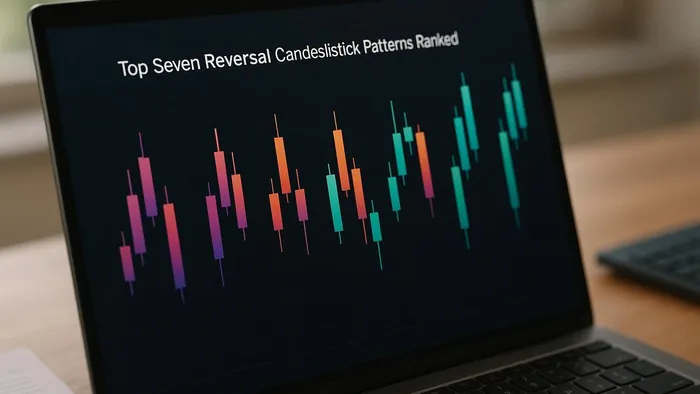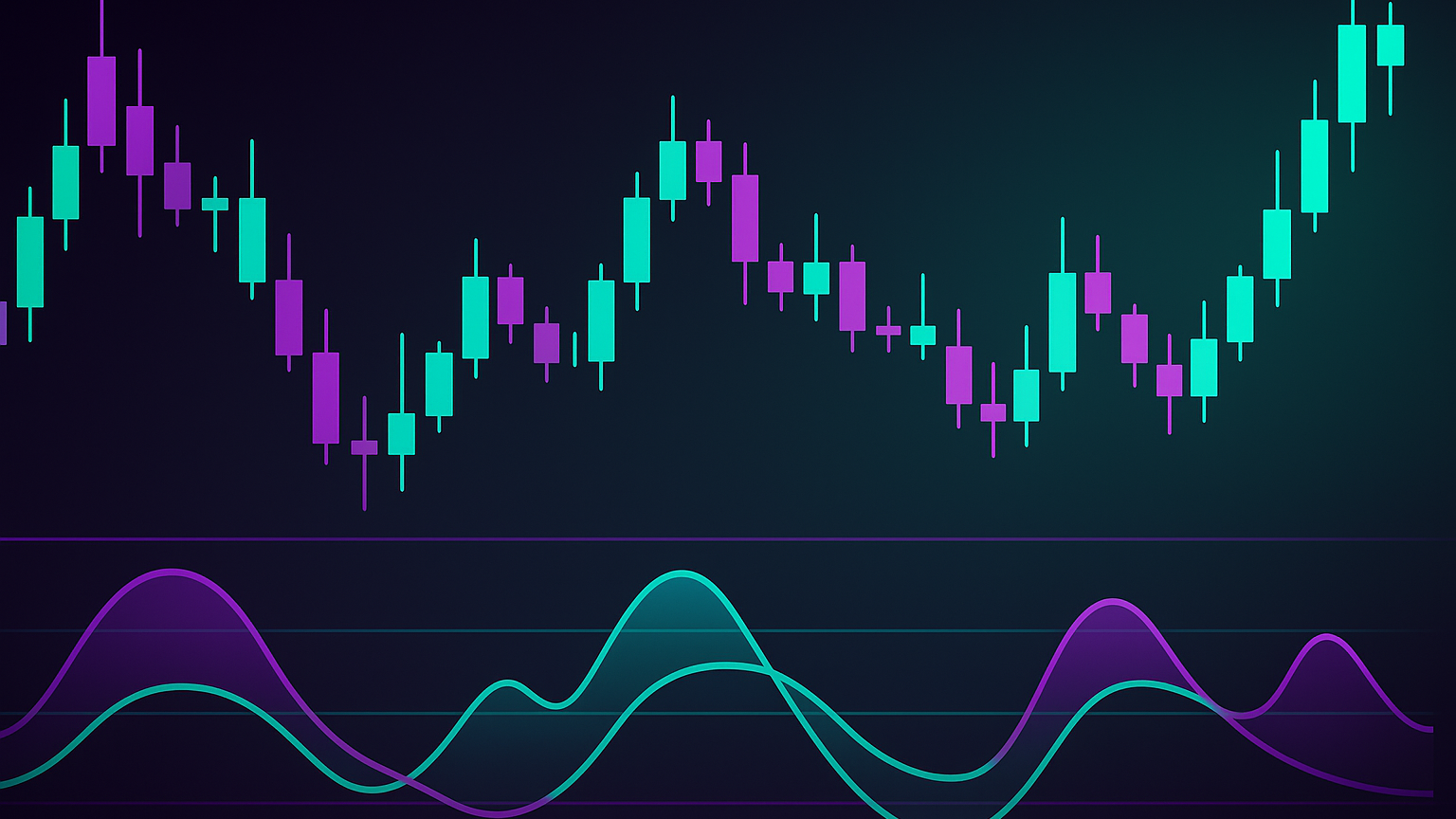Explore the top seven reversal candlestick patterns that can signal market turning points and enhance your trading strategies.
- Hammer: A bullish reversal pattern common in downtrends. Look for a small body near the top of the range and a long lower shadow.
- Inverted Hammer: Signals a potential bullish reversal with a small body near the bottom and a long upper shadow, often forming during downtrends.
- Bullish Engulfing: A two-candle pattern where a large green candle completely engulfs a small red candle, indicating strong buying pressure.
- Bearish Engulfing: The opposite of the Bullish Engulfing, where a large red candle engulfs a smaller green candle, signaling potential selling pressure.
- Morning Star: A three-candle pattern marking a bullish reversal, starting with a long bearish candle, followed by a small indecisive candle, and ending with a strong bullish candle.
- Evening Star: A bearish reversal pattern and the counterpart to the Morning Star, signaling the end of an uptrend.
- Shooting Star: A single bearish candle with a small body near the bottom of the range and a long upper shadow, typically forming at the peak of an uptrend.
Quick Comparison
| Pattern | Accuracy Potential | Frequency | Ease of Identification | Best Market Conditions |
|---|---|---|---|---|
| Hammer | High | Common | Moderate | Downtrends near support |
| Inverted Hammer | Moderately High | Occasional | Moderate | During consolidation |
| Bullish Engulfing | High | Common | Easy | After a strong downtrend |
| Bearish Engulfing | High | Common | Easy | After a strong uptrend |
| Morning Star | Very High | Less Frequent | Complex | Extended downtrends |
| Evening Star | Very High | Less Frequent | Complex | Extended uptrends |
| Shooting Star | Moderate | Occasional | Moderate | Reversal in uptrends |
Key Takeaways
- Combine these patterns with volume analysis and technical indicators such as RSI or moving averages for better accuracy.
- Use stop-loss orders strategically to manage risk.
- Patterns are more reliable near key support or resistance levels.
These patterns are tools, not guarantees, so always confirm them with additional analysis.
10 Powerful Candlestick Reversal Patterns Every Trader Must Know
How These Patterns Were Ranked
We assessed reversal candlestick patterns using three main factors: historical accuracy, how often they occur, and how easy they are to spot.
Historical Accuracy
| Pattern Type | Historical Accuracy | Occurrence Frequency |
|---|---|---|
| Three Black Crows | 78% | Moderate |
| Evening Star | 72% | Common |
| Bullish Abandoned Baby | 70% | Rare |
| Two Black Gapping | 68% | Frequent |
Pattern Recognition Criteria
Each pattern was judged on two critical factors:
- Volume confirmation – patterns with above-average volume tend to be more reliable.
- Technical confluence – best-performing patterns align with support and resistance, trend-line interactions, or moving-average crossovers.
"Trading candlesticks without any other confluence is not recommended …" – Rolf
1. Hammer Pattern

The Hammer pattern is a well-known bullish reversal signal that often appears at the end of downtrends, suggesting a potential price reversal.
Reliability of Signal
- Standalone success rate: 40-60%.
- Reliability improves near support, with higher-than-average volume, and after a bullish confirmation candle.
Frequency of Occurrence
The Hammer frequently appears during downtrends, offering traders multiple opportunities to spot potential bottoms.
How to Identify
- Small real body near the top of the range.
- Lower shadow at least twice the length of the body.
- Little to no upper shadow.
- A closing price above the open strengthens the signal.
Risk / Reward Considerations
| Component | Strategy |
|---|---|
| Entry | Buy above the Hammer’s high after confirmation. |
| Stop-loss | Below the Hammer’s low. |
| Target | Nearest resistance or 2-3 × risk distance. |
| Volume | Look for increased volume on Hammer or confirmation candle. |
2. Inverted Hammer Pattern

The Inverted Hammer signals a possible bullish reversal and typically appears at the end of a downtrend.
Reliability of Signal
- Encyclopedia success rate: 67%.
- Higher volume, bullish body color, and proximity to support enhance reliability.
Frequency of Occurrence
Common in downtrends across many time frames.
How to Identify
- Small body at the lower end of the range.
- Upper shadow at least twice the body length.
- Little to no lower shadow.
Typical Risk / Reward
| Component | Strategy |
|---|---|
| Entry | Buy above the high after bullish confirmation. |
| Stop-loss | Below the pattern’s low. |
| Target | 2-3 × risk distance or nearest resistance. |
3. Bullish Engulfing Pattern

The Bullish Engulfing pattern is a two-candlestick formation that signals a potential reversal in a downtrend.
Reliability of Signal
- Success rate: 63%.
- Accuracy rises after four or more bearish candles, near support, and on strong volume.
Frequency of Occurrence
12th most common among 103 candlestick patterns (S&P 500, 1950-2018).
How to Identify
| Component | Criteria |
|---|---|
| Market context | Must appear in a clear downtrend. |
| First candle | Small bearish body. |
| Second candle | Bullish body fully engulfs first candle. |
Typical Risk / Reward
| Element | Strategy |
|---|---|
| Entry | Buy above the engulfing candle’s high. |
| Stop-loss | Below the pattern’s low. |
| Target | Next resistance level. |
4. Bearish Engulfing Pattern

The Bearish Engulfing pattern suggests a potential reversal in an uptrend.
Reliability of Signal
- Success rate: 79%.
- Strengthens near resistance and on above-average volume.
Frequency of Occurrence
Most common near key resistance levels in uptrends.
How to Identify
- Smaller bullish candle followed by larger bearish candle.
- Bearish body fully engulfs bullish body.
Risk / Reward Considerations
| Component | Action |
|---|---|
| Entry | Sell below engulfing candle’s low. |
| Stop-loss | Above engulfing candle’s high. |
| Confirmation | Gap down or another bearish candle. |
5. Morning Star Pattern

The Morning Star is a bullish three-candle reversal pattern typically found at the bottom of a downtrend.
Reliability of Signal
- Historical success rate: 60-75%.
- Third candle closing > 50 % into first candle and higher volume improve reliability.
Frequency of Occurrence
Often appears around major support zones.
How to Identify
| Component | Features |
|---|---|
| First candle | Long bearish body. |
| Second candle | Small indecisive body, usually gapping down. |
| Third candle | Long bullish body closing > 50 % into first candle. |
Typical Risk / Reward
- Buy above third candle’s high, stop below pattern low, target next resistance.
6. Evening Star Pattern

The Evening Star is a three-candle bearish reversal pattern that often signals the end of an uptrend.
Reliability of Signal
- Overall success rate: ≈ 70 %.
- Most reliable on daily charts with high third-candle volume.
Frequency of Occurrence
Relatively rare, which makes the signal more significant when it appears.
How to Identify
| Component | Characteristics |
|---|---|
| First candle | Large bullish body. |
| Second candle | Small indecisive body. |
| Third candle | Large bearish body closing deep into first candle. |
Typical Risk / Reward
- Sell below third candle’s low, stop above pattern high, target prior support.
7. Shooting Star Pattern

The Shooting Star is a single-candle pattern at the peak of an uptrend, hinting at a bearish reversal.
Reliability of Signal
- Strongest near resistance with red body and heavy volume.
- Always confirm with subsequent bearish action.
Frequency of Occurrence
Common after sharp rallies.
How to Identify
- Upper shadow ≥ 2 × body length.
- Small body near session low.
- Little to no lower shadow.
Typical Risk / Reward
| Application | Description |
|---|---|
| Entry | Sell below low of Shooting Star. |
| Stop-loss | Above pattern high. |
| Targets | Prior support zones. |
Pattern Comparison Chart
This quick reference highlights each pattern’s key traits:
| Pattern | Accuracy | Frequency | Ease | Risk / Reward | Best Conditions |
|---|---|---|---|---|---|
| Hammer | Generally high | Common | Moderate | Good | Downtrends near support |
| Inverted Hammer | Moderately high | Occasional | Moderate | Good | Consolidating downtrends |
| Bullish Engulfing | High | Common | Easy | Good | After strong downtrends |
| Bearish Engulfing | High | Common | Easy | Good | After strong uptrends |
| Morning Star | Very high | Less frequent | Complex | High | Extended downtrends |
| Evening Star | Very high | Less frequent | Complex | High | Extended uptrends |
| Shooting Star | Moderate | Occasional | Moderate | Modest | Reversal signals in uptrends |
Pattern Selection Criteria
- Day traders prefer frequent patterns such as Hammers and Engulfings.
- Swing traders often favor Morning / Evening Stars.
- Position traders rely on multiple confirmations over longer time frames.
The Role of Market Context
Patterns work better with volume confirmation and when they form near key support / resistance levels across multiple time frames.
Risk Management Tips
- Place stop-loss orders just beyond the pattern’s extreme point.
- Use take-profit targets that maintain a favorable risk / reward ratio.
- Confirm patterns with indicators such as RSI, MACD, or moving averages.
Using LuxAlgo to Find These Patterns
After ranking the reversal patterns, automated detection becomes essential. LuxAlgo provides tools that make it easier to spot and confirm these candlestick setups. The Reversal Candlestick Structure indicator detects the seven primary patterns covered here plus nine additional formations in real time.
Real-Time Pattern Detection
The indicator blends candlestick analysis with a stochastic oscillator to filter false signals and focus on genuine reversals.
| Setting | Purpose | Impact |
|---|---|---|
| Trend Length | Period for trend analysis | Affects sensitivity |
| Threshold | Criteria for validation | Reduces false alarms |
| Warm-up Length | Historical data required | Ensures accuracy |
Visual Features
- Dynamic color coding shows reversal strength.
- Patterns clearly labeled on-chart.
- Automatic support / resistance levels.
- Risk / stop markers tied to momentum extremes.
Pattern Performance Dashboard
A live dashboard displays the percentage of successful reversals so traders can adjust their strategies quickly.
Advanced Reversal Detection
- Momentum Phase – measures trend strength and flags exhaustion (especially candles 8-9).
- Trend Exhaustion Phase – highlights zones where reversals are likely, helping with entries, stops, and targets.
Customizable Alerts
- Pattern completions
- Support / resistance crossings
- Risk-level violations
- Long / short trade setups
Trading Tips and Risk Management
Converting pattern analysis into profitable trades requires disciplined risk management.
Strategic Stop-Loss Placement
| Pattern | Stop-Loss Placement | Purpose |
|---|---|---|
| Bullish Engulfing | Below candle’s low | Protects against false breakouts |
| Bearish Engulfing | Above candle’s high | Guards against upward reversals |
| Hammer / Inverted Hammer | Below shadow | Maintains pattern validity |
| Morning / Evening Star | Outside three-candle range | Preserves signal integrity |
Position Sizing Guidelines
"Position sizing is the glue that holds together a sound trading system …"
- Brijesh Bhatia, Equity Capital Market Analyst
Example for a $25 000 account using the 2 % rule on TSLA:
- Max risk: $500
- Risk / share: $30 (entry $225, stop $195)
- Shares: $500 / $30 ≈ 16
- Position: 16 × $225 = $3 600
Volume & Price-Level Integration
Confirm patterns with volume spikes and alignment to support / resistance to increase trade confidence.
Risk-Management Best Practices
- Risk ≤ 2 % of capital per trade.
- Enter trades only after full pattern formation.
- Use trailing stops to lock profits.
- Adjust strategy to market volatility; cut size 25-50 % in high-volatility periods.
- Maintain a trading journal to track performance.
Conclusion
Mastering reversal candlestick patterns helps traders identify potential turning points. In January 2000, Sun Microsystems rallied sharply after two Bullish Engulfings—proof that these formations can precede major moves.
To boost reliability:
- Multi-time-frame confirmation
- Volume spikes on pattern completion
- Technical confluence with support / resistance, moving averages, volume indicators, or momentum oscillators
Combined with disciplined risk management, these tactics create a solid framework for trading market reversals.
FAQs
How can I use volume analysis to confirm reversal candlestick patterns?
Higher-than-average volume during pattern formation shows stronger conviction. For bullish reversals, a volume spike means buyers are stepping in; for bearish reversals, it shows aggressive selling. This added confirmation reduces false signals.
What’s the difference between a Hammer and an Inverted Hammer?
A Hammer has a long lower wick and signals buyers rejected lower prices. An Inverted Hammer has a long upper wick, showing buyers tested higher prices but closed near the low. Both appear at the end of downtrends and need confirmation with volume or other indicators.
Why use other indicators with reversal candlesticks?
Combining patterns with indicators like RSI or moving averages verifies overbought / oversold conditions and trend direction, filtering false entries and boosting confidence.








